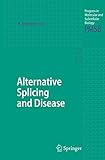Alternative Splicing and Disease / edited by Philippe Jeanteur.
Tipo de material: TextoSeries Progress in Molecular and Subcellular Biology ; 44Editor: Berlin, Heidelberg : Springer Berlin Heidelberg, 2006Descripción: xii, 257 páginas 26 ilustraciones 2 en color. recurso en líneaTipo de contenido:
TextoSeries Progress in Molecular and Subcellular Biology ; 44Editor: Berlin, Heidelberg : Springer Berlin Heidelberg, 2006Descripción: xii, 257 páginas 26 ilustraciones 2 en color. recurso en líneaTipo de contenido: - texto
- computadora
- recurso en línea
- 9783540344490
- QH573-671
Springer eBooks
Methods and Platforms for the Quantification of Splice Variants' Expression -- Pre-mRNA Missplicing as a Cause of Human Disease -- Alternative Splicing: Therapeutic Target and Tool -- SR Proteins as Potential Targets for Therapy -- Misregulation of Tau Alternative Splicing in Neurodegeneration and Dementia -- Spinal Muscular Atrophy and Therapeutic Prospects -- Misregulation of Alternative Splicing Causes Pathogenesis in Myotonic Dystrophy -- Redirecting Splicing to Address Dystrophin Mutations: Molecular By-pass Surgery -- Altered Splicing in Prelamin A-Associated Premature Aging Phenotypes -- Splicing Modulation as a Modifier of the CFTR Function.
Splicing of primary RNA transcript, i.e. removal of introns and joining of exons to produce mature mRNAs competent for translation into proteins, is a quasi-systematic step of gene expression in higher organisms. However, this process is not unequivocal but can follow alternate pathways. Alternative splicing of a given transcript can therefore yield several distinct mRNAs encoding as many different proteins. Its full biological significance has not been appreciated until it was recognized that alternative splicing is so general as to affect about 75% of all human genes. Therefore, alternative splicing not only vastly increases protein diversity but also offers numerous opportunities for aberrant splicing events with pathological consequences.
Para consulta fuera de la UANL se requiere clave de acceso remoto.


